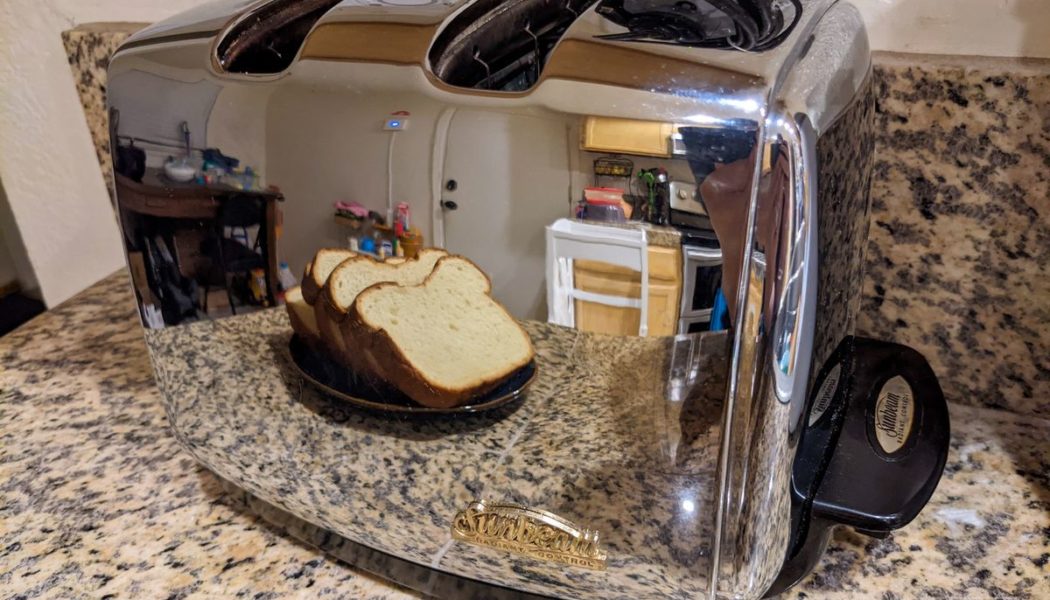My colleague Tom once introduced you to a modern toaster with two seemingly ingenious buttons: one to briefly lift your bread to check its progress, and another to toast it “a bit more.” I respectfully submit you shouldn’t need a button at all.
That’s because in 1948, Sunbeam engineer Ludvik J. Koci invented the perfect toaster, one where the simple act of placing a slice into one of its two slots would result in a delicious piece of toasted bread. No button, no lever, no other input required. Drop bread, get toast.
Some of you are no doubt already connoisseurs who know what I’m referring to: the Sunbeam Radiant Control Toaster, sold from 1949 all the way through the late ‘80s. (It goes by many names, including the T-20A, T-20-B, T20-C, T-35, VT-40, AT-W and even the 20-30-AG.) In 2019, the YouTube channel Technology Connections famously explained precisely why the antique Sunbeam Radiant is better than yours, and it might be the smartest thing you watch today.
[embedded content]
But if you don’t have the time just now, I’ll summarize: When you stick a piece of bread into this toaster, it pushes down a series of cleverly designed levers that have just enough tension to lower and raise two slices all by themselves — and it’s got a mechanical thermostat inside that stops your bread toasting when it’s toasted and ready, NOT after some arbitrary amount of time.
With the Sunbeam, the heat radiating from the bread itself warms up a bimetal strip (one of the simplest kinds of thermostats) which, being made of two different kinds of metal that expand at different rates, ends up bending backwards to sever the connection and stop the flow of electricity when the toast is done. And here’s the most ingenious part: when the heating wire shrinks as it cools down, that is what triggers the mechanical chain reaction that lifts your bread back up. Here’s how Sunbeam describes it in the toaster’s official service manual:
Raising or lowering of the bread is obtained by making use of the energy of expansion and contraction of the Center Element wire. Of course, this movement is very small and is measured in thousandths of an inch, but more than adequate carriage movement is obtained by a simple linkage which multiplies this movement approximately 175 times.
And that mechanism doesn’t just wear out after nearly three-quarters of a century of use: there’s a single screw underneath the crumb tray to adjust the tension of the wire, and it alone is enough to bring many aging toasters back to life.
So yeah: drop bread, get toast. And like Technology Connections points out, you get toast regardless of whether your bread is room temperature, refrigerated, or frozen when you stick it into the device.
That also makes it remarkably hard to accidentally burn your bread by toasting it too long! Remember the “A bit more” button on Tom’s toaster? The Sunbeam Radiant Control Toaster does that merely by dropping a toasted piece of bread back in the slot — it warms the bread right back to the temperature at which it browns, which browns the bread slightly more, before it trips the thermostat once again and shuts itself off.
:no_upscale()/cdn.vox-cdn.com/uploads/chorus_asset/file/23042415/shollister_toaster_20200911.jpg)
By now, you might have guessed I wasn’t satisfied watching a YouTube video — I bought my own off eBay. And then I bought a second and a third, because it turns out a Space Age artifact that produces delicious food is just the kind of wonderful conversation piece that makes for a wonderful gift, too. (Before giving them, I opened them up and replaced their aging power cords with modern grounded three-prong ones, as many of these predate even polarized plugs and are not remotely safe by modern electrocution prevention standards.)
There are good arguments that the Sunbeam Radiant Control Toaster still isn’t perfect. For one thing, there’s no ding to remind you when the toast is done — though these 1275- and 1375-watt toasters are powerful enough you might as well stick around for the minute or two it takes. (Let your tea steep, grab your butter and preserves.)
You’re also not going to toast bagels in these easily, since the thermostat’s aimed at the center of your piece of bread. Frozen waffles come out fantastic, but I have to carefully split English muffins perfectly in half so they don’t catch on the guide wires. And while slices of square sandwich bread crisp up beautifully, including the thin-cut Taiwan toast from my local bakery, thick or oblong breads don’t necessarily fit. (A wide slice of Oroweat Buttermilk or Nature’s Own Brioche Style might require a quick flip-and-retoast to crisp all the way across.)
But when it works, which is most of the time, the result is the kind of crisp-on-the-outside, fluffy-and-moist-on-the-inside piece of toast my mom tells me she hasn’t had since she left her own mother’s kitchen.
:no_upscale()/cdn.vox-cdn.com/uploads/chorus_asset/file/23042706/shollister_toaster_20210710.jpg)
I admit I’ve never tried a Balmuda, the $300 toaster oven where you add a splash of water so it “locks in the bread’s inner moisture before the surface is given a golden brown finish.” But I have to wonder if quickly crisping the outside with a dedicated vertical toaster, instead of baking it a second time in a miniature oven, might be a more elegant solution? I do own a Panasonic FlashXpress, which often takes home best toaster oven awards, and its perfectly browned slices definitely don’t have the same taste the Sunbeam can provide.
:no_upscale()/cdn.vox-cdn.com/uploads/chorus_asset/file/23042705/shollister_toaster_20210709.jpg)
If you find yourself in the market for a Sunbeam Radiant yourself, you should know they’re not all quite the same — you can read about the differences here and here — and you may have to pay quite a bit. They go for an average of $130 on eBay, with fully restored models fetching two to four times that at auction. (Tim’s Toasters also promises to restore your existing Sunbeam for $250, though I can’t vouch for their work myself.)
Is that actually a lot? The Sunbeam T-20 reportedly retailed for over $22.50 brand new back in 1949. That’s $260 in today’s money, which may be why no other company has seemingly bothered to replicate its fully automatic charms.
This Thanksgiving, I thought I’d raise a toast to the ultimate toaster. We may never see its like again.








